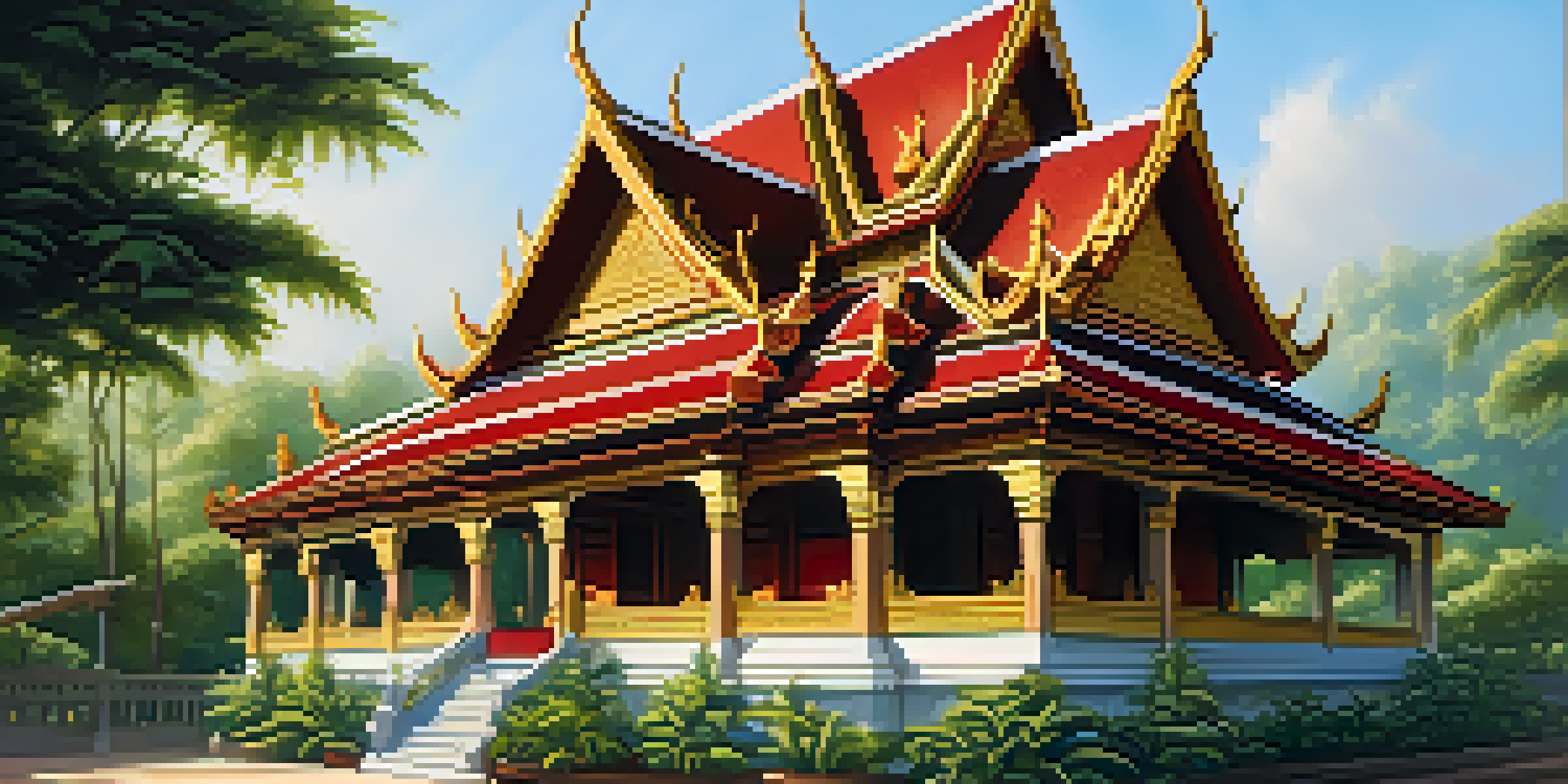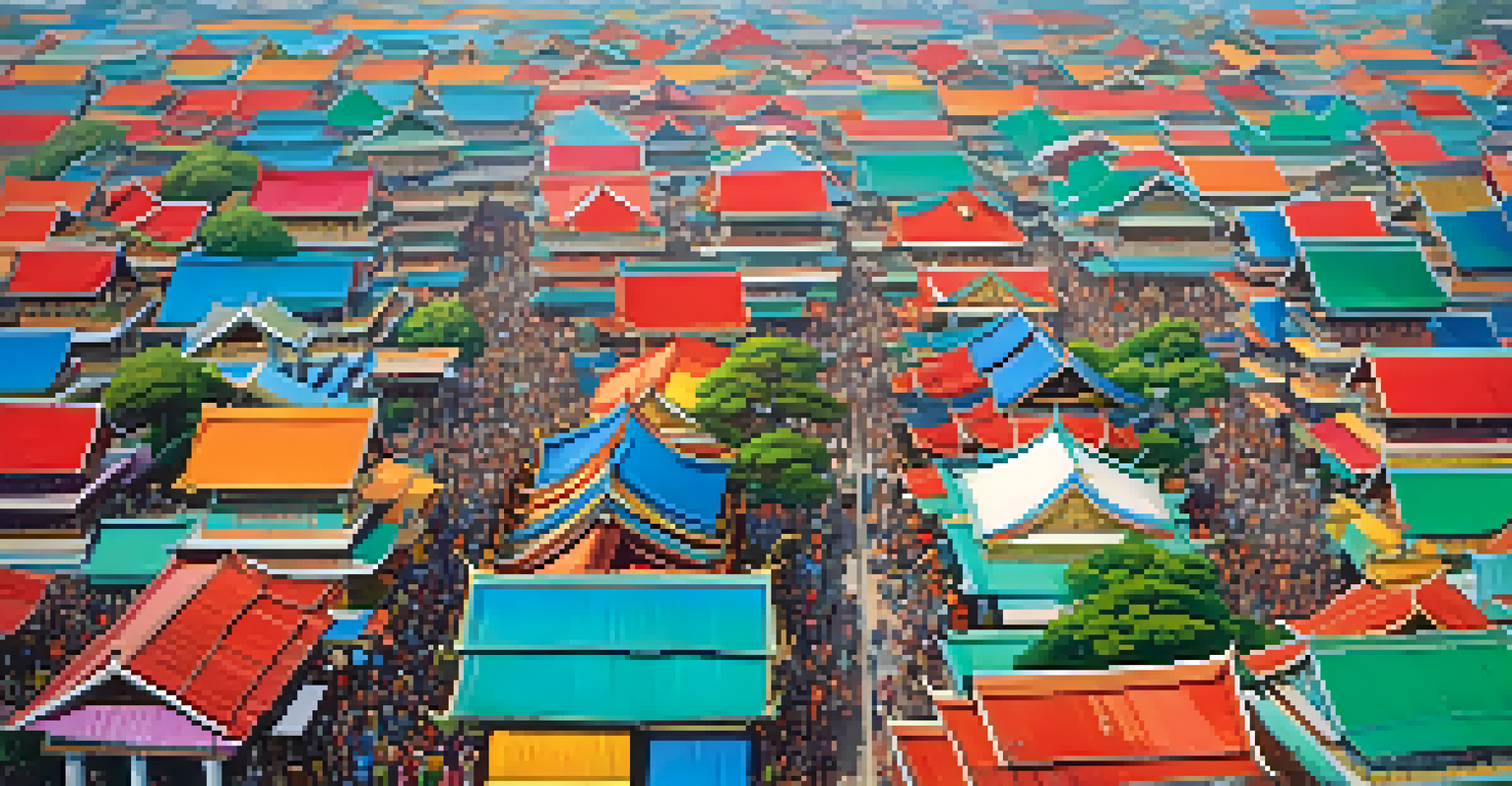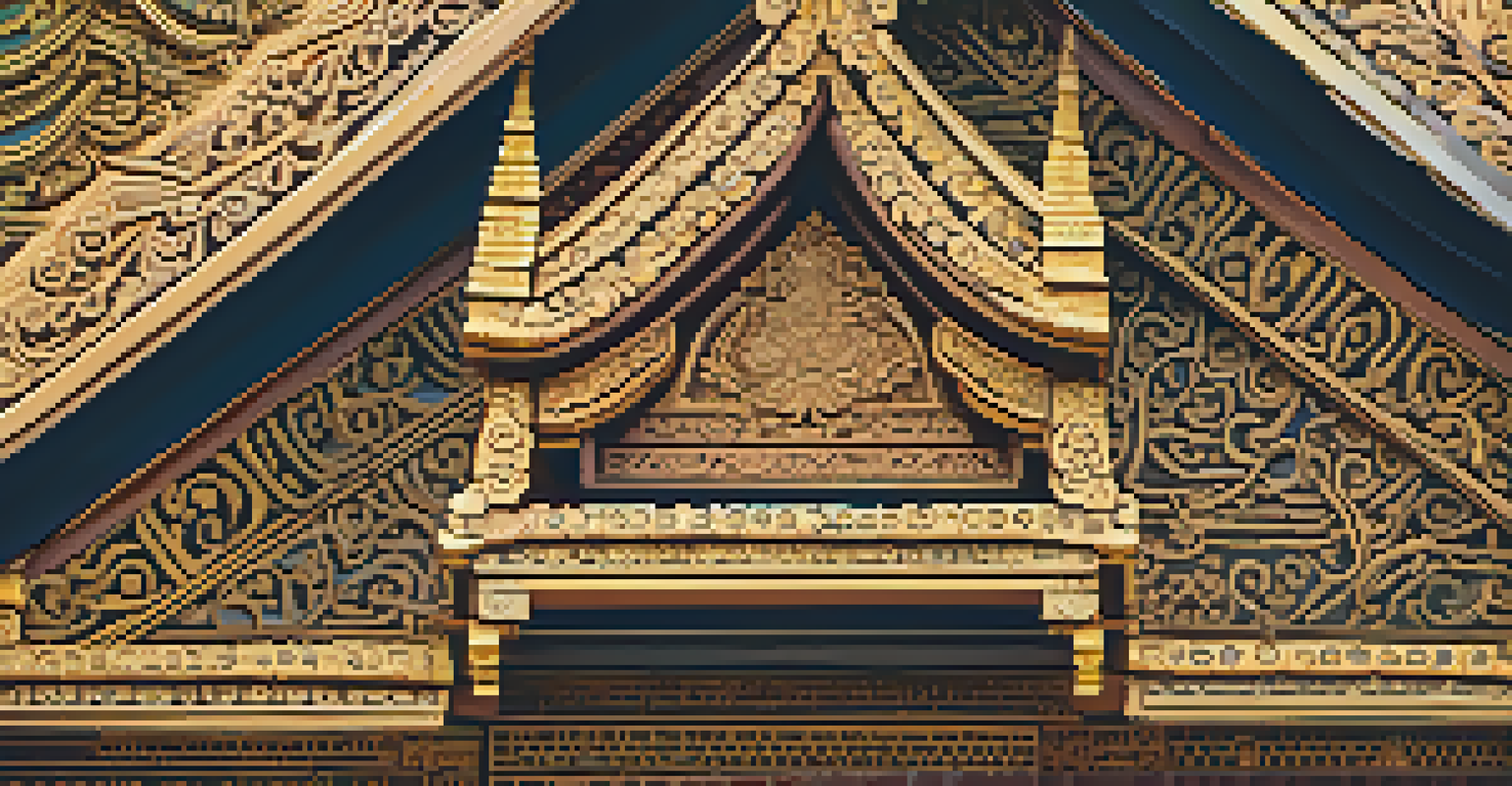The Symbolism Behind Thai Roof Designs and Structures

Understanding the Basics of Thai Roof Architecture
Thai roof architecture is a fascinating blend of tradition and innovation. The roofs are not only functional but also serve as an artistic expression of Thai culture. Typically featuring steep angles and intricate designs, these structures are designed to handle heavy rain and tropical weather. This unique architectural style has evolved over centuries, reflecting the region's history and climate.
Architecture is the will of an epoch translated into space.
In Thailand, roofs are often adorned with vibrant colors and detailed carvings, which highlight the craftsmanship of local artisans. The shapes of these roofs can vary significantly, from the classic gable to the more elaborate tiered designs. Each variation tells a story of the local customs and beliefs, making Thai roofs stand out in the world of architecture.
Moreover, the roofs are designed with cultural significance in mind, serving as a symbol of protection and prosperity. They are seen as a way to honor the spiritual aspects of life, connecting the physical structure to the beliefs and values of the community. Understanding these basics sets the stage for a deeper exploration of the symbolism behind these remarkable designs.
Symbolism of Roof Shapes in Thai Architecture
The shape of a Thai roof can convey different meanings and significance. For instance, the classic gable roof represents stability and permanence, reflecting the importance of family and home in Thai culture. On the other hand, the tiered roofs symbolize the connection between the earth and the heavens, with each layer representing a higher level of spirituality.

Additionally, the upward curves at the ends of the roofs are not just aesthetic; they symbolize the aspiration for enlightenment and the desire to reach higher spiritual realms. This design element is often found in temples, where the architecture is intended to inspire reverence and a sense of the divine. Such symbolic shapes help create a harmonious relationship between the natural and spiritual worlds.
Cultural Significance of Roofs
Thai roofs are not just functional; they embody cultural values, beliefs, and artistic expression, reflecting the community's identity.
In essence, each roof shape tells a story, deeply rooted in the cultural values of the Thai people. By understanding these symbols, one can appreciate the intricate relationship between architecture and spirituality in Thai society. This connection adds layers of meaning to the stunning visuals that define the landscape.
Colors and Their Significance in Thai Roofs
Colors play a vital role in Thai roof designs, each hue carrying its own significance. For example, gold is often used to symbolize wealth and prosperity, while red represents good fortune and joy. These colors are not merely decorative; they reflect the beliefs and aspirations of the community.
The best architect is not the one who has the most tools, but the one who has the most understanding of the place and the people.
In addition, the use of vibrant colors is a way to honor the spirits and ancestors, creating a connection between the present and the past. The careful selection of color schemes can also be seen in temple architecture, where the colors enhance the spiritual atmosphere. This thoughtful approach to color demonstrates the importance of visual symbolism in Thai culture.
Ultimately, colors in Thai roofs are a celebration of life, inviting positivity and good energy into the space. By integrating these colors into their designs, Thai architects create structures that resonate with the community’s values and beliefs. This vibrant expression of culture is an essential aspect of what makes Thai architecture so captivating.
The Spiritual Connection of Thai Roofs
In Thai culture, roofs are often viewed as a protective barrier against negative energies and spirits. This belief is deeply rooted in the idea that the roof serves as a guardian, keeping the inhabitants safe and secure. Many traditional homes and temples are built with this spiritual connection in mind, emphasizing the importance of protection in everyday life.
Moreover, the placement and orientation of the roofs can also hold spiritual significance. For instance, roofs that face certain directions are believed to harness positive energy from the surrounding environment. This careful consideration of orientation highlights the intricate relationship between architecture and spirituality in Thai culture.
Symbolism in Roof Design
The shapes and colors of Thai roofs carry deep meanings, representing stability, spirituality, and prosperity within Thai culture.
As a result, the roofs are not only functional but also serve as a bridge between the physical and spiritual realms. This connection enriches the cultural landscape, allowing for a deeper appreciation of the harmony that exists within Thai architecture. Understanding this aspect can transform how one views these beautiful structures.
Cultural Influences on Thai Roof Design
Thai roof designs have been influenced by various cultures over the centuries, creating a unique architectural style. Elements from Indian, Chinese, and Khmer architecture can be seen in the intricate details and overall structure. This blend of influences showcases the adaptability and openness of Thai culture to incorporate diverse ideas.
One notable example is the influence of Buddhism, which has shaped many architectural features, including the roofs of temples. The designs often reflect Buddhist principles, promoting harmony and balance through their aesthetic. This cultural interplay highlights how Thai architecture evolves while still honoring its roots.
Furthermore, as globalization increases, modern influences are also making their way into traditional designs. While this evolution is important, it raises questions about preserving cultural identity. Understanding these cultural influences allows us to appreciate the richness of Thai architecture and the stories it tells.
The Role of Roofs in Thai Community Life
Roofs in Thailand serve as more than just a shelter; they play a crucial role in community life. Many homes and buildings have open spaces under the roofs, providing a gathering area for families and neighbors. This design fosters social interactions, reinforcing the sense of community that is central to Thai culture.
In rural areas, the space under the roofs is often utilized for various activities, from cooking to celebrations. These communal spaces become a hub of daily life, emphasizing the importance of togetherness in Thai society. The architectural design encourages a lifestyle that values relationships and communal harmony.
Modern Adaptations of Tradition
Contemporary architects are blending traditional Thai roof designs with modern materials and techniques, ensuring cultural significance persists.
Additionally, during festivals and special events, these spaces are transformed into vibrant venues for celebrations. The roofs not only protect the participants but also symbolize the unity and joy of the community. This aspect of Thai architecture highlights the integral role that roofs play in fostering social bonds.
Modern Adaptations of Traditional Thai Roofs
As society evolves, so do the designs of Thai roofs. Modern architects are experimenting with traditional styles, incorporating contemporary materials and techniques while preserving cultural significance. This fusion creates stunning designs that respect heritage while catering to modern needs.
For example, architects are exploring sustainable materials that enhance energy efficiency without compromising aesthetics. This shift not only reflects global trends but also aligns with traditional Thai values of respecting nature. The result is a harmonious blend of the old and the new, showcasing the adaptability of Thai architecture.

Ultimately, these modern adaptations highlight the resilience of Thai culture in the face of change. By embracing innovation, architects are ensuring that the rich symbolism of Thai roofs continues to thrive in contemporary society. This balance between tradition and modernity is what makes Thai architecture truly unique.